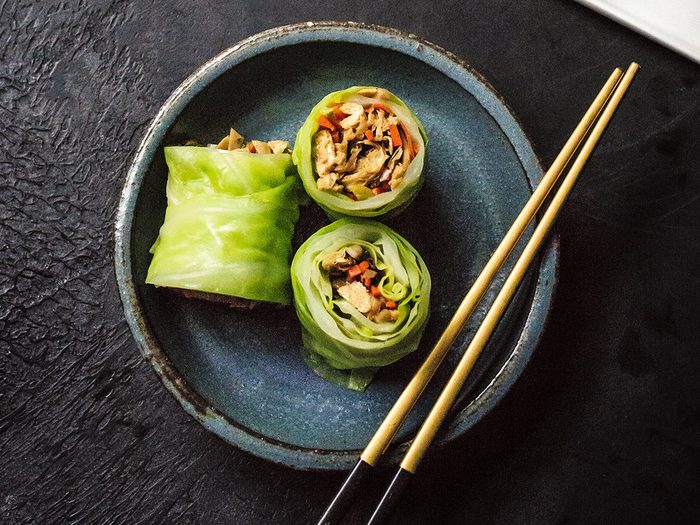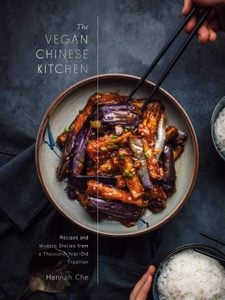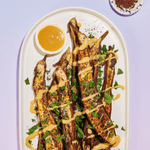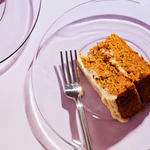These Vegan Rolls With Fried Peanuts Are Sure to Be a Family Favourite

A recipe for stuffed cabbage rolls, excerpted from the cookbook The Vegan Chinese Kitchen by Hannah Che
In a traditional temple dish, blanched cabbage leaves are stuffed, wrapped individually, steamed, and served in a clear sauce. I love the filling but usually roll the leaves into a sushi-style log instead, for a more finger-friendly version that preserves the cabbage’s bright, jewel-like colors. Each bite begins with crisp-tender, sweet cabbage, followed by chewy, savory mushrooms and tofu skin, threads of caramelized sweetness from the carrot, and a gentle crunch from peanuts and cilantro. Enjoy the sliced rolls on their own or with soy sauce and a dab of wasabi (jie mo).
Stuffed Cabbage Rolls
Bāocài juˇan
包菜卷
Serves 4 to 6
Ingredients
- Kosher salt
- 1 pound (450 grams) green cabbage, preferably flat-head cabbage, leaves separated (about 20 leaves)
- 2 tablespoons vegetable oil or Scallion Oil
- 1 tablespoon minced garlic
- 1 medium king oyster mushroom (6½ ounces / 180 grams), both caps and stems thinly julienned
- 1 small carrot, thinly julienned
- 2 teaspoons soy sauce
- 4 ounces (112 grams) fresh or frozen and thawed tofu skin, cut into thin shreds
- ½ teaspoon ground cumin
- ½ teaspoon sugar
- ¼ teaspoon ground white pepper, or to taste
- ½ cup coarsely chopped fresh cilantro
- ¹⁄₃ cup crushed Fried Peanuts
- 1 teaspoon toasted sesame oil
Directions
Bring a large pot of generously salted water to a boil. Add the cabbage leaves and blanch until they are softened and vibrant green, about 1 minute. Refresh in cold water and drain in a colander.
Heat a wok over medium heat. Add the vegetable oil and swirl to coat the sides of the wok. Add the garlic and cook until aromatic, about 15 seconds. Add the mushrooms, carrot, and soy sauce. Stir-fry until the mushrooms have softened and released their liquid, about 3 minutes. Add the tofu skin, cumin, sugar, white pepper, and ½ teaspoon salt and stir until the tofu skin is heated through, scraping down any parts that stick to the wok. Remove from the heat and stir in the cilantro and crushed peanuts. Taste and add more salt, if needed. Transfer the filling to a bowl.
Lay one cabbage leaf on a cutting board and shave off its thick stem, trimming it as thin as possible without cutting into the leaf. The pared-down spine will make the leaf flatter and easier to bend. Repeat with the remaining leaves. Toss them in a large bowl with the sesame oil to lightly coat, giving the leaves a shine and aroma.
Lay out a bamboo sushi mat (or cover a tea towel with plastic wrap). Place a third of the leaves across the mat and flatten them. Place a third of the filling on the cabbage leaves, spreading it evenly and leaving an inch of the leaves exposed at the top and bottom. Hook your thumbs under the mat and lift the edge closest to you up and over the filling in the center. Press gently with curved hands along the length of the “log,” then pull the edge of the mat toward you and continue to roll the cabbage up and away from you. When you reach the far edge of the cabbage leaves, press the roll tightly once more, then remove the mat. Repeat with the remaining cabbage leaves and filling to make 2 more rolls. With a sharp serrated knife, slice the rolls into 2-inch-wide segments.
Enjoy immediately or chill before serving.

Excerpted from The Vegan Chinese Kitchen by Hannah Che. Copyright © 2022 Hannah Che. Photographs by Hannah Che. Published by Appetite by Random House®, a division of Penguin Random House Canada Limited. Reproduced by arrangement with the Publisher. All rights reserved.
Next: This Coconut Clay Pot Taro & Edamame Is the Vegan Dish You Need This Season




